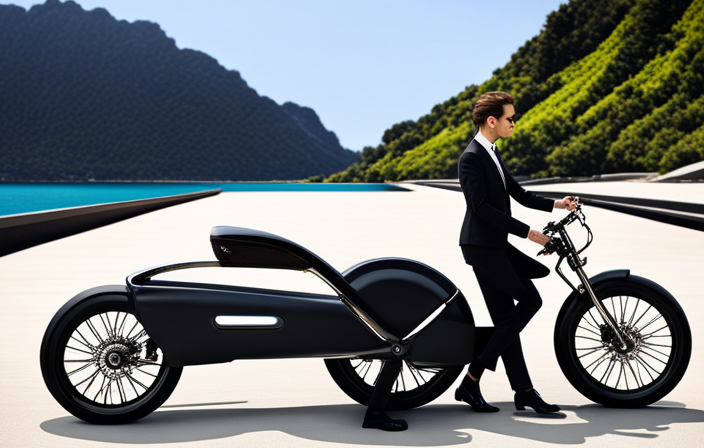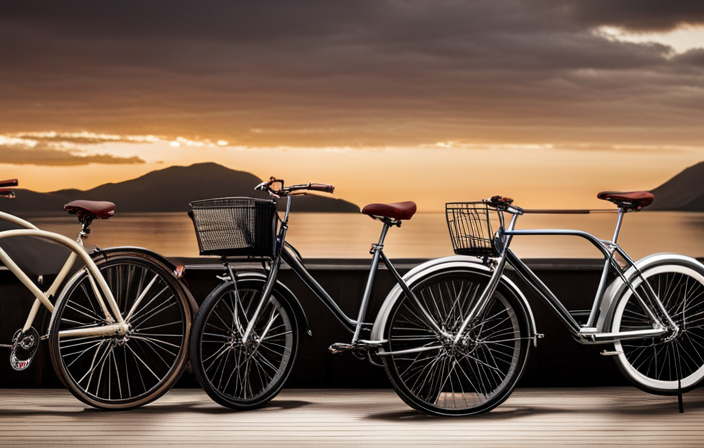You might believe you understand what a bike is, however, have you ever been introduced to an electric bike? Get ready to be amazed as we explore the captivating realm of this cutting-edge form of transportation.
With a history dating back to the late 19th century, electric bikes have come a long way in terms of technology and design. In this article, we will explore how they work, the different types available, the benefits of riding one, and much more.
Buckle up, because the electric bike revolution is just getting started!
Key Takeaways
- Electric bikes provide assistance when going uphill.
- They are cost-effective in the long run and require less maintenance and no fuel costs.
- Electric bikes are suitable for individuals with physical limitations or new to cycling.
- They reduce greenhouse gas emissions and contribute to a more efficient and sustainable transportation network.
History of Electric Bikes
The electric bike has a fascinating history. It all began with the innovation and advancements made in the late 1800s. During this time, inventors started experimenting with electric motors and batteries, and soon enough, the first electric bicycles were born. These early models were heavy and had limited range, but they paved the way for future developments.
As technology progressed, electric bikes became more popular in the 20th century, especially in countries like Japan and the Netherlands. Today, electric bikes have come a long way, thanks to advancements in battery technology and motor efficiency. They are now lighter, have longer ranges, and offer various levels of assistance to riders.
Understanding the history of electric bikes helps us appreciate how they work and how they have evolved over time. Now, let’s dive into the next section and learn how electric bikes work.
How Electric Bikes Work
Contractions power electric bikes, utilizing electric bike motor technology. Electric bikes offer a range of advantages, including efficiency, environmental friendliness, health benefits, and cost savings.
- Efficiency: Electric bikes convert energy into motion with minimal waste.
- Environmental friendliness: Electric bikes produce zero emissions, reducing air pollution and carbon footprint.
- Health benefits: Riding an electric bike provides exercise and improves cardiovascular health.
- Cost savings: Electric bikes have lower fuel and maintenance costs compared to traditional bikes or cars.
Electric bikes are a game-changer in transportation, providing a sustainable and practical solution for commuting and recreational purposes. Now, let’s delve into the different types of electric bikes.
Types of Electric Bikes
There are various types of e-bikes available in the market. Each type is designed to cater to different needs and preferences. The most common types include city e-bikes, mountain e-bikes, folding e-bikes, and cargo e-bikes.
City e-bikes are perfect for commuting and urban riding, with features like fenders and lights. Mountain e-bikes are built for off-road adventures, with rugged frames and powerful motors. Folding e-bikes are compact and portable, making them ideal for easy storage and transportation. Cargo e-bikes are designed to carry heavy loads, with sturdy frames and spacious cargo areas.
Using electric bikes has several advantages. They provide assistance with pedaling, allowing you to ride longer distances and tackle challenging terrains with ease. They also reduce the physical strain on your body, making them a great option for people with physical limitations or health issues. Additionally, electric bikes are eco-friendly, emitting zero emissions and reducing your carbon footprint.
Transitioning into the next section, riding an electric bike not only offers these advantages, but it also brings a multitude of benefits to your overall well-being.
Benefits of Riding an Electric Bike
Experience the numerous benefits of riding an e-bike and enhance your overall well-being.
-
Boost your cardiovascular health: Riding an electric bike provides an excellent cardiovascular workout, helping to improve your heart health and increase stamina.
-
Reduce stress levels: Feel the wind in your hair as you effortlessly glide through traffic, reducing stress and promoting a sense of relaxation and tranquility.
-
Save money on transportation costs: With an e-bike, you can say goodbye to expensive gas prices and parking fees. Enjoy the freedom of commuting without breaking the bank.
-
Go green and reduce your carbon footprint: By choosing to ride an electric bike, you contribute to a cleaner environment, reducing air pollution and greenhouse gas emissions.
-
Improve mental well-being: The combination of exercise, fresh air, and the thrill of riding can boost your mood, reduce anxiety, and enhance overall mental well-being.
Now, let’s delve into the fascinating world of electric bike components and features.
Electric Bike Components and Features
Get ready to explore the various components and features that make e-bikes so unique and exciting. When it comes to electric bike components, the two key elements are the battery and the motor. Electric bike battery technology has seen significant advancements in recent years, allowing for longer rides and faster charging times. The motor power, measured in watts, determines how much assistance the bike provides while pedaling. Higher wattage motors are capable of delivering more power, making it easier to tackle hills or ride at higher speeds.
To help you visualize the importance of these components, here’s a table showcasing some popular electric bike models and their battery capacity and motor power:
| Electric Bike Model | Battery Capacity | Motor Power |
|---|---|---|
| Model A | 500 Wh | 250 W |
| Model B | 750 Wh | 500 W |
| Model C | 1000 Wh | 750 W |
Understanding the capabilities of different electric bike components will help you make an informed decision when choosing the right electric bike for your needs. Now, let’s move on to the next section and explore how to find the perfect e-bike that suits you best.
Choosing the Right Electric Bike for Your Needs
When choosing the right e-bike for your needs, it’s important to consider factors such as terrain, distance, and desired level of assistance. Here are some tips for selecting an electric bike:
-
Terrain: Consider the type of terrain you will be riding on. If you’ll be mostly riding on flat roads, a bike with a lower power motor may be sufficient. However, if you’ll be tackling hills or rough terrains, a bike with a higher power motor and larger battery capacity would be more suitable.
-
Distance: Think about the distance you’ll be traveling on a regular basis. If you have a long commute or plan on taking longer rides, opt for a bike with a larger battery capacity to ensure you have enough power to reach your destination without running out of charge.
-
Level of assistance: Determine how much assistance you want from the electric motor. Some bikes offer multiple levels of assistance, allowing you to choose how much effort you want to exert while riding.
-
Budget: Set a budget for your electric bike and look for options within that price range. Keep in mind that higher quality components and features will generally come at a higher cost.
When it comes to maintenance and care for electric bikes, it’s important to keep your bike clean, check the tire pressure regularly, and have the battery and motor serviced as recommended by the manufacturer.
Maintenance and Care for Electric Bikes
To properly maintain and care for your e-bike, it’s essential to regularly clean it, check tire pressure, and follow manufacturer recommendations for servicing the battery and motor. By incorporating these maintenance tips, you can ensure your electric bike stays in top condition and performs optimally. Here are some troubleshooting common issues you may encounter:
-
Battery Not Holding a Charge: Check the connections and clean any corrosion. If the issue persists, consult the manufacturer for further assistance.
-
Motor Malfunction: Inspect the motor for any loose wires or debris. If necessary, contact a professional for repairs.
-
Braking Problems: Regularly check the brake pads for wear and adjust as needed. If the brakes still aren’t functioning properly, seek professional help.
-
Strange Noises: Unusual sounds can indicate a problem with the chain, gears, or bearings. Have a bike mechanic inspect and fix the issue if necessary.
With these maintenance tips and troubleshooting techniques, you can keep your electric bike running smoothly. Moving on to electric bike laws and regulations…
Electric Bike Laws and Regulations
Make sure you’re familiar with the laws and regulations surrounding the use of e-bikes in your area. This is crucial for electric bike safety and to avoid any legal issues.
Here are some important statistics and guidelines to keep in mind:
- Always wear a helmet when riding an electric bike to protect yourself in case of accidents.
- Follow the designated bike lanes and paths to ensure the safety of both yourself and other riders.
- Be aware of the speed limits for e-bikes in your area and avoid exceeding them.
- Respect pedestrian rights and yield to them when necessary.
Understanding and abiding by these regulations will not only keep you safe but also contribute to a positive image of electric bike users in your community.
Now let’s explore the pros and cons of electric bikes compared to regular bikes.
Electric Bikes vs. Regular Bikes: Pros and Cons
One advantage of e-bikes compared to regular bikes is their ability to provide assistance when going uphill. Electric bikes have a motor that helps you pedal, making it easier to conquer steep inclines without getting exhausted. This can be especially beneficial for individuals who may have physical limitations or are new to cycling.
Additionally, electric bikes offer health benefits similar to regular bikes, such as improved cardiovascular fitness and increased calorie burn. As for cost comparison, while electric bikes are generally more expensive upfront, they can save you money in the long run. They require less maintenance and no fuel costs, making them a cost-effective transportation option.
Transitioning into the subsequent section about tips for riding an electric bike safely, it’s important to understand the various safety considerations to ensure a smooth and enjoyable ride.
Tips for Riding an Electric Bike Safely
Ensure your safety while riding an e-bike by following these helpful tips. Riding an electric bike can be an enjoyable and efficient mode of transportation, but it’s important to know the proper riding techniques and be aware of common safety hazards. Here are some tips to keep you safe on the road:
- Always wear a helmet to protect your head in case of accidents.
- Master the art of braking, as e-bikes can be heavier and have different braking systems than regular bikes.
- Be mindful of your speed and adjust it according to the road conditions and traffic.
Table:
| Riding Techniques | Common Safety Hazards | Electric Bike Accessories and Upgrades |
|---|---|---|
| Proper posture and balance | Uneven road surfaces | Upgraded lights for better visibility |
| Gradual acceleration and deceleration | Pedestrians and other cyclists | Rearview mirrors for increased awareness |
| Signal your intentions | Distracted drivers | Locks and alarms for theft prevention |
By following these tips, you can ride your e-bike safely and confidently. Now, let’s explore some essential accessories and upgrades for your electric bike.
Electric Bike Accessories and Upgrades
Now, let’s check out some must-have accessories and upgrades for your e-bike.
When it comes to electric bike accessories, there are a few essentials that can enhance your riding experience.
First, consider investing in a quality helmet to prioritize your safety on the road.
Additionally, a sturdy bike lock is crucial to protect your e-bike from theft.
To make your rides more comfortable, consider adding a suspension seatpost or a gel seat cover.
Another useful accessory is a rear rack or panniers, which can provide extra storage space for your belongings.
When it comes to upgrades, consider getting a larger battery pack for longer rides or upgrading to a more powerful motor for increased speed and performance.
These electric bike accessories and upgrades can significantly improve your overall biking experience.
Moving on to the next section about the environmental impact of electric bikes, it’s important to consider their positive contribution to a greener future.
Environmental Impact of Electric Bikes
The environmental impact of e-bikes is a key aspect to consider when discussing their role in creating a greener future. Electric bikes have the potential to reduce greenhouse gas emissions and air pollution, as they do not rely on fossil fuels for operation.
Additionally, the infrastructure required for electric bikes is minimal compared to traditional vehicles, reducing the need for extensive road construction and maintenance.
Furthermore, e-bikes can have a positive impact on public transportation systems by providing an alternative mode of transportation for short to medium distance trips. This can alleviate congestion and reduce the reliance on cars and buses, ultimately leading to a more efficient and sustainable transportation network.
As we delve into the topic of electric bike charging and battery life, it is important to understand the environmental benefits and potential of these innovative vehicles.
Electric Bike Charging and Battery Life
Now that you understand the environmental impact of electric bikes, let’s delve into the world of electric bike charging and battery life.
One of the key aspects of owning an electric bike is ensuring that you have access to an efficient charging infrastructure. Electric bike charging stations are becoming more prevalent, allowing you to conveniently charge your bike while you’re out and about.
Additionally, there are various methods to extend the battery life of your electric bike, such as avoiding extreme temperatures and properly maintaining the battery.
To help you navigate this topic further, here are three important considerations:
- The availability and location of charging stations in your area
- Tips and tricks for maximizing battery life
- The different types of chargers and their charging times.
Understanding these factors will empower you to make the most of your electric bike experience.
Now, let’s explore popular electric bike brands and models.
Popular Electric Bike Brands and Models
If you’re in the market for a new ride, you might want to check out some popular electric bike brands and models. When it comes to electric bikes, there are a variety of options available for every budget and preference.
One popular brand is Rad Power Bikes, known for their affordable pricing and reliable performance. Their models, such as the RadRunner and RadCity, offer impressive battery life and efficient power delivery.
Another well-known brand is Trek, offering a range of electric bikes with different price points and features. Their models, like the Verve+ and Powerfly, are designed for comfort and versatility.
Whether you’re looking for a budget-friendly option or a high-end electric bike, these brands have something to offer.
Now, let’s delve into the future trends in electric bike technology.
Future Trends in Electric Bike Technology
One of the future trends in e-bike technology is the integration of artificial intelligence to enhance rider experience. With advancements in AI, electric bikes are expected to become smarter and more intuitive, providing a seamless and personalized riding experience.
Here are four future innovations that will have a significant impact on transportation:
-
Intelligent Navigation Systems: AI-powered navigation systems will analyze real-time data such as traffic conditions, weather, and road conditions to provide riders with the most efficient routes and improve overall safety.
-
Predictive Maintenance: AI algorithms will monitor the bike’s components and predict potential issues before they occur, allowing for proactive maintenance and reducing the risk of breakdowns.
-
Smart Charging Stations: AI-enabled charging stations will optimize energy usage based on demand and usage patterns, ensuring efficient charging and reducing the strain on the power grid.
-
Enhanced Safety Features: AI algorithms will detect potential hazards on the road and provide warnings to riders, reducing the risk of accidents.
These future innovations will revolutionize electric bikes and reshape the future of transportation.
Frequently Asked Questions
Are electric bikes allowed on all bike trails and paths?
Yes, electric bikes are allowed on many bike trails and paths, but the regulations vary depending on the specific location. Some trails may have speed limits or restrictions on motor power, while others may prohibit electric bikes altogether.
However, in general, electric bikes offer numerous benefits such as increased speed, reduced effort during uphill climbs, and extended range. They are a popular choice for commuters and recreational riders alike, providing a convenient and eco-friendly transportation option.
Can electric bikes be ridden in the rain?
Yes, electric bikes can be ridden in the rain. However, it’s important to adjust your riding technique and perform proper maintenance to ensure safety and longevity.
When riding in the rain, be cautious of slippery surfaces and take turns and corners slowly. This will help you maintain control and reduce the risk of accidents.
After riding in the rain, it’s crucial to dry your bike thoroughly. This will prevent water from seeping into sensitive components and causing damage. Additionally, it’s a good idea to lubricate the chain to prevent rust and ensure smooth operation.
Regularly checking your brakes, tires, and lights is also important. This will help you identify any signs of wear and tear that may have been exacerbated by riding in wet conditions. By addressing these issues promptly, you can ensure that your electric bike remains safe and reliable.
In conclusion, riding an electric bike in the rain is possible, but it requires some adjustments and extra care. By following these guidelines and performing regular maintenance, you can enjoy your electric bike even in wet weather conditions.
Are electric bikes suitable for long-distance commuting?
Electric bikes are a great option for long-distance commuting. With an impressive electric bike range of up to 80 miles on a single charge, you can easily cover the distance without worrying about running out of battery.
Not only do electric bikes provide a convenient and eco-friendly mode of transportation, but they also offer numerous benefits such as reducing traffic congestion, improving cardiovascular health, and saving money on fuel costs.
So hop on an electric bike and enjoy a smooth and efficient commute!
How often do electric bike batteries need to be replaced?
Electric bike battery lifespan depends on various factors. On average, most electric bike batteries need to be replaced after 2-4 years of regular use. However, this can vary depending on factors such as battery quality, usage patterns, and maintenance.
High-quality batteries and proper care can prolong their lifespan. Regular charging, avoiding extreme temperatures, and not overcharging can help extend battery life. It is essential to follow the manufacturer’s guidelines and consult a professional if you notice a significant decline in battery performance.
Are there any age restrictions for riding an electric bike?
To ensure safety, age restrictions are often in place for riding an electric bike. These restrictions vary depending on the country or state, but generally, riders must be at least 16 years old.
It is vital to follow these regulations as electric bikes can reach higher speeds and require proper handling. Additionally, make sure to take necessary safety precautions, such as wearing a helmet and understanding local traffic laws, to ensure a safe and enjoyable ride.
Conclusion
So now you have a better understanding of what electric bikes are and how they work. They are a convenient and eco-friendly alternative to traditional bicycles and cars, allowing you to travel longer distances without breaking a sweat.
Electric bikes come in various types, from commuter bikes to mountain bikes, catering to different riding preferences. With their growing popularity, many well-known brands like Trek and Specialized are now offering electric bike models.
As technology continues to advance, we can expect even more exciting features and improvements in the future. For example, imagine a scenario where you effortlessly navigate through busy city streets on your electric bike, reaching your destination in record time, all while reducing your carbon footprint.
The possibilities with electric bikes are endless, so why not give them a try and experience the joy of electric-powered cycling yourself?
















